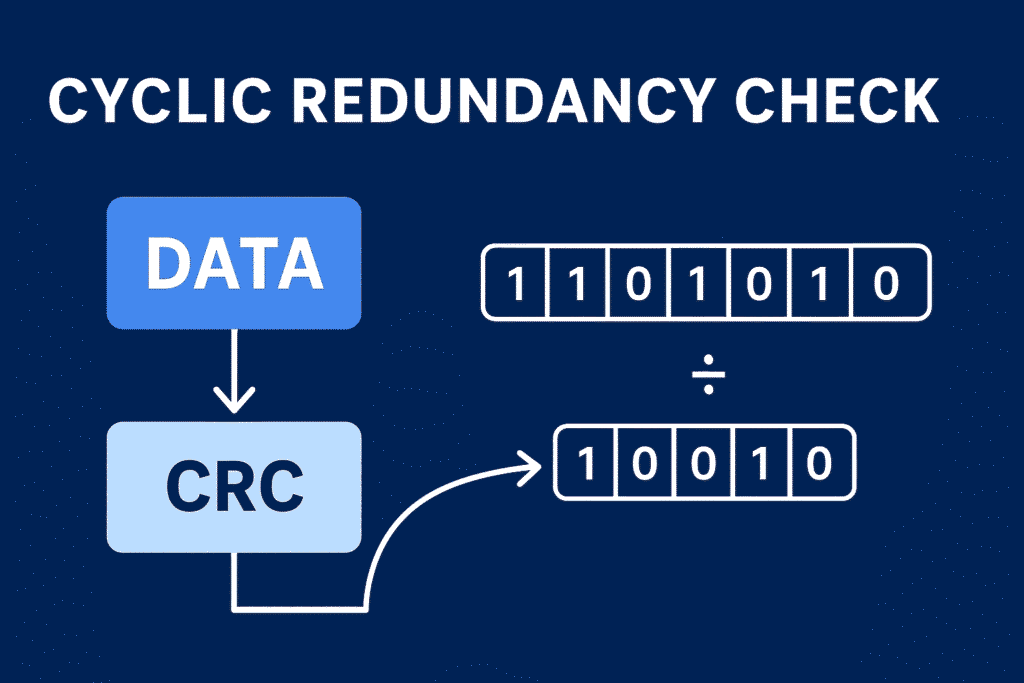Cyclic Redundancy Check (CRC): Definition, Working, Types, and Applications
The Cyclic Redundancy Check(also known as CRC) is one of the famous error-detection techniques used in communication networks and storage media. It is to make sure that the transferred or stored data does not get corrupted during transfer or retrieval. CRC is really best at detecting accidental changes in data very quickly and reliably. Hence, it has become an integral part of any modern communication system, hard drive, CD, DVD, and file compression format.
This guide will discuss everything about CRC, which includes its working mechanism, types, advantages, and disadvantages, along with real-life applications.
What is Cyclic Redundancy Check (CRC)?
A mathematical algorithm called a Cyclic Redundancy Check detects accidental errors in raw data. It generates a short, fixed-length binary sequence (called CRC code or checksum) based on the original data, which either transmits or stores alongside data.
During the retrieval or reception of data, the system recalculates the CRC and matches it against the original CRC. If they match, the system considers the data error-free. However, if they do not match, it is an indicator that corruption has occurred.
Why CRC is Important
- Data Integrity – CRC guarantees the immutability of the data during transmission or storage.
- Error Detection – It can detect errors quickly, which commonly occur due to noise, hardware malfunction, or network issues.
- Efficiency – The developers designed the algorithm to be very lightweight, allowing easy embedding in either hardware or software implementations.
- Reliability – CRC reliably detects burst errors that simpler checks, such as parity bits, generally may not detect.
How CRC Works: Step-by-Step Guide
In a CRC, a predefined polynomial performs binary division to arrive at the checksum. Basically:
- Data Representation – The original data is represented as a binary string.
- Polynomial Selection – The predetermined divisor (generator polynomial) is agreed upon by both sender and receiver.
- Append Zeros – The data is appended with a number of zeros equal to the degree of the polynomial.
- Binary Division – Using modulo-2 arithmetic, the data is divided by the generator polynomial.
- Generate CRC Code – The remainder of the division is the CRC code.
- Transmit Data + CRC – The data, along with the CRC code, is carried out for transmission.
- Verification – The receiver performs the same division process on the received data. If the remainder is zero, the data is intact.

CRC Calculation Example
Given:
- Data: 1101011011
- Generator Polynomial: 10011
Steps:
- Step 1: Append zeros = 1101011011 0000
- Step 2: Divide using modulo-2 binary division.
- Step 3: Assuming the remainder is 1010, it becomes the CRC code.
- Step 4: The message sent over is: 1101011011 1010.
Once the receiver obtains the data, dividing it by 10011 occurs. If the remainder is 0000, then the transmission is free of errors.
Types of CRC
Different polynomials and bit lengths find their uses in different applications. Commonly known types include:
1. CRC-8
- Uses an 8-bit polynomial.
- Common in small data packets (e.g., automotive networks).
2. CRC-16
- Uses a 16-bit polynomial.
- Widely used in USB, Modbus, and SD cards.
3. CRC-32
- Uses a 32-bit polynomial.
- Common in Ethernet, PNG files, ZIP archives.
4. CRC-64
- Uses a 64-bit polynomial.
- Used in advanced storage systems for higher accuracy.
Applications of CRC
Applied in various industries and technological domains:
1. Networking
Detects data corruption inside Ethernet frames, Wi-Fi packets, and any other form of communication.
2. Storage Devices
Ensures the integrity of files stored in hard disks, SSDs, CD-ROMs, and DVD-ROMs.
3. File Formats
Checks for suspected errors for PNG, ZIP, RAR, and other file compression formats.
4. Embedded Systems
Most often used in firmware updates to check for errors that may have occurred during transfer.
5. Data Transmission Protocols
Used in data transmission protocols such as PPP, CAN bus, and SATA.
Advantages of CRC
- Very good at detecting burst errors.
- Quite low in computational cost — very efficient in hardware and software.
- Scalable — different bit lengths for different applications.
Limitations of CRC
- No error correction — CRC can only detect errors, cannot correct them.
- Detection is not perfect — A few very special, rare error patterns may still get through undetected.
- It needs to have the polynomial configured beforehand — The sender and receiver must agree on the polynomial.
CRC vs. Other Error Detection Methods
| Feature | CRC | Parity Bit | Checksum |
| Error Detection | High | Low | Medium |
| Burst Error Detection | Yes | No | Limited |
| Speed | High | Very High | High |
| Error Correction | No | No | No |
Best Practices when Using CRC
- Choose the polynomial that fits your application the most.
- In very critical applications, use it together with an error correcting code.
- Be sure to test your CRC implementation on software regularly to avoid logic errors.
- For speed-conscious systems, make sure that CRC hardware acceleration is being leveraged.
Conclusion
The Cyclic Redundancy Check (CRC) remains one of the most trusted methods for random accidental corruption detection. Due to their efficiency, reliability, and adaptability, CRCs become paramount in digital communication and data storage systems.
Just like that … from Ethernet cables to ZIP files, CRC secretly works to ensure that whatever we send and store reaches the destination intact — demonstrating perhaps that the most important technologies are the ones we rarely notice.
Key Takeaways:
- CRC is an error-detection algorithm based on polynomial division.
- CRC gets employed in networks, storage, and file formats.
- The strength of the CRC lies in its speed, accuracy, and performance-based efficiency-but it does not correct errors.
See This Also: Explaining the OPSEC Cycle: The Stages, Significance, and an Actual Real-World Scenario

